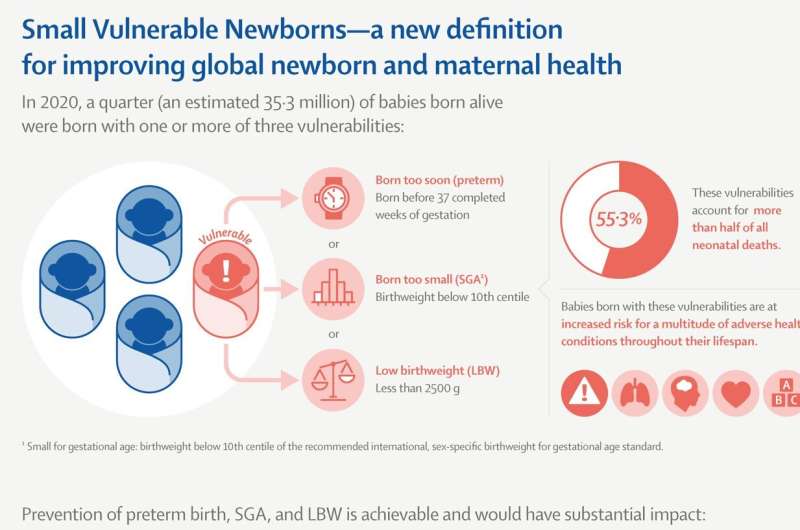This article has been reviewed according to Science X's editorial process and policies. Editors have highlighted the following attributes while ensuring the content's credibility:
fact-checked
peer-reviewed publication
trusted source
proofread
An estimated 1 million stillbirths and newborn baby deaths could be prevented each year with low-cost solutions

Eight low-cost and easily implementable proven interventions for pregnant women in 81 low- and middle-income countries (LMICs) could prevent an estimated 566,000 stillbirths and 5.2 million babies a year from being born preterm or small for gestational age—some with low birth weight—the impacts of which would also affect long-term health and economic output, says a new four-paper Series published in The Lancet.
Additionally, the eight interventions (multiple micronutrient supplements, balanced protein energy supplements, aspirin, treatment of syphilis, education for smoking cessation, prevention of malaria in pregnancy, treatment of asymptomatic bacteriuria and progesterone provided vaginally) along with two proven interventions that can reduce the complications of preterm births (antenatal corticosteroids and delayed cord clamping) have the potential to prevent 476,000 newborn baby deaths. The Series estimates the cost of implementing these interventions at $1.1 billion in 2030.
In a new analysis, the Lancet Series on small vulnerable newborns estimates that, of the 135 million babies born alive in 2020, one in four (35.3 million) were born preterm or small for gestational age—some with low birth weight. The Series brings this group together under a new term: small vulnerable newborns (SVN). These babies were born in every country, with the majority in Sub-Saharan Africa and Southern Asia.
The authors highlight that, in every region, progress for reducing preterm birth and low birthweight is a flat line and off track of targets—the Global Nutrition Target calls for 30% reduction of babies with low birthweight by 2030 from a 2012 baseline, however the estimated annual rate of reduction is only 0.59%.
In a global call to action, the Series argues for a higher quality of care for women during pregnancy and at birth, and specifically for the scale-up of pregnancy interventions in 81 LMICs, which the Series estimates could prevent approximately 32% of stillbirths, 20% of newborn baby deaths and 18% of all SVN births in those countries.
Given over 80% of births are in facilities, the authors underline that better data collection and use of data is possible now, ensuring that every pregnancy is dated with accurate gestational age and all newborns—as well as all stillbirths—weighed and classified by SVN type.
In addition to helping ensure good quality care, the Series says better data collection is essential to inform progress and drive accountability. Counting stillbirths is important to capture the full burden, since new analyses in the Series highlights that 74% of stillbirths were born preterm for a subset of countries.
Prof Per Ashorn, Tampere University, Finland and a lead author on the Series, says, "Despite several global commitments and targets aimed at reducing SVN outcomes since 1990, every fourth baby in the world is 'born too small' or 'born too soon'. Our Series suggests that we already have the knowledge to reverse the current trend and save the lives of 100,000s of babies a year at a cost of $1.1 billion, a fraction of what other health programs receive. We need national actors, with global partners, to urgently prioritize action, advocate and invest."
More information: The Lancet Small Vulnerable Newborns Series, The Lancet (2023). www.thelancet.com/series/small-vulnerable-newborns




















